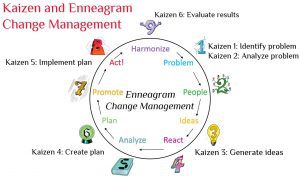
We cannot become what we want to be by remaining what we are.
— Max DePree
Kaizen is a Japanese business philosophy of continuous improvement. It was first practiced in Japan after World War II. In rebuilding their industrial base, Japan’s industrialists looked to American business and quality-management practices, particularly those of W. Edwards Deming. The Toyota Way famously came out of this period. These practices came to be called Kaizen, the Japanese word for improvement, and have been popularized around the world in the wake of Japan’s successful rebuilding of its industries after the war.
While Kaizen is considered more a way of being—a culture—than a methodology, it does incorporate a six-step process depicted as a circle with step 6 leading back to step 1. Here is a typical outline of the steps:
Kaizen Step 1: Identify a problem
Kaizen Step 2: Analyze the problem
Kaizen Step 3: Generate solution ideas
Kaizen Step 4: Create implementation plan
Kaizen Step 5: Implement the plan
Kaizen Step 6: Evaluate the results
Enneagram Change Management (ECM) uses a nine-step approach also depicted as a circle with step 9 leading back to step 1. Here are the nine steps of Enneagram Change Management:
ECM Step 1: Problem-Goal. Identify the problems, define the goals.
ECM Step 2: Stakeholder Identification. Recruit a committed team.
ECM Step 3: Ideation. Generate ideas for solutions.
ECM Step 4: Emotional Reaction. Assess reactions to each of the ideas.
ECM Step 5: Logical Analysis. Study and score promising ideas.
ECM Step 6: Planning. Select the most promising idea and build an action plan.
ECM Step 7: Promotion. Passionately promote the plan, get approval to proceed.
ECM Step 8: Implementation. Execute the plan, solve the problem!
ECM Step 9: Integration. Confirm the problem is solved with all stakeholders.
Let’s see how these two approaches compare—what’s similar, what’s different and what’s missing?
Where are the People?
The first thing that strikes me is that the Kaizen approach makes no explicit reference to people whereas the Enneagram approach explicitly has four touchpoints that take people into consideration:
ECM Step 2: Stakeholder Identification. Recruit a committed team.
ECM Step 4: Emotional Reaction. Assess reactions to each of the ideas.
ECM Step 7: Promotion. Passionately promote the plan, get approval to proceed.
ECM Step 9: Integration. Confirm the problem is solved with all stakeholders.
In ECM Step 2 the team considers all the people who are affected by the problem—the stakeholders—while the Kaizen approach does not include a step that explicitly includes all related parties.
ECM Step 4 considers how stakeholders are emotionally reacting to proposed solutions—this is the emotional filter out of which come the ideas with the most positive emotional energy. Kaizen does not take emotional reactions explicitly into account.
After creating an implementation plan, that plan needs to be “sold” to all stakeholders—this is Step 7 in the Enneagram approach. Kaizen skips the step of stakeholder buy-in.
After implementation, both approaches assess results. ECM Step 9 and Kaizen Step 6 are similar, but the Enneagram approach explicitly incorporates feedback from all stakeholder perspectives. Kaizen Step 6 may do this implicitly, while Enneagram Change Management takes an explicit, people-oriented approach.
Problem Problem
The first two of the six Kaizen steps are devoted to the problem itself. Step 1 is identifying the problem and step 2 is analyzing the problem. Clearly, the people who developed the Kaizen approach were very focused on problems! (Probably Enneagram Type 1s.) ECM Step 1 is also problem identification, which includes analyzing the problem to whatever depth is necessary to really understand it. The Enneagram approach also includes the flip side of the problem, not only how things shouldn’t be but also how they should be—the world envisioned once the problem is solved. The Kaizen approach does not explicitly include a vision statement.
Ideas and Plans
While the Kaizen approach skipped over the people-centric steps of the Enneagram approach, there is overlap on ideation—step 3 in both systems—and plan creation, step 4 with Kaizen and step 6 with Enneagram. With Enneagram Change Management, each idea generated in Step 3 goes through two explicit filters, the emotional filter ECM Step 4 described above, and the logical filter ECM Step 5. Since neither of those filters are explicitly mentioned with Kaizen, I suspect that ECM Step 4 is included implicitly with Kaizen Step 3, and ECM Step 5 is included implicitly with Kaizen Step 4. I assume that ECM Step 7—stakeholder buy-in—is also included in Kaizen Step 4.
Continuous Improvement
The last two steps of both systems are essentially the same, the implementation step—Kaizen Step 5 and ECM Step 8—and the debrief step—Kaizen Step 6 and ECM Step 9. Whenever there is transformational change, inevitably new issues and problems arise which is why both systems depict this process as a never-ending circle of continuous improvement. Both systems highlight and intrinsically value the importance of the cyclicity of problem solving.
People–Process–Purpose
While I am a big fan of the Kaizen approach and used it early in my career, I realized that it can be quite clinical and not take people into account. The Enneagram approach explicitly includes people in the process and is indeed a superset of the Kaizen approach, including all steps in Kaizen in the same order! That Kaizen does not explicitly include people speaks more to the personality styles of the people who created Kaizen than Kaizen itself. And that both systems are so similar, in that both include cyclicity and that the overlapping steps are in the same order, speaks to the fundamental manner in which humans—individuals and teams—solve problems and improve their circumstances.
Finally, the most fascinating aspect of the Enneagram is that it also serves as a nine-type personality system with a one-to-one mapping of a personality dynamic and a step in problem solving. The Enneagram tells us that there is a human dynamic that is ideally suited for each step in problem solving! Doesn’t this imply that the Enneagram is the operating system for the human dynamics of problem solving?
